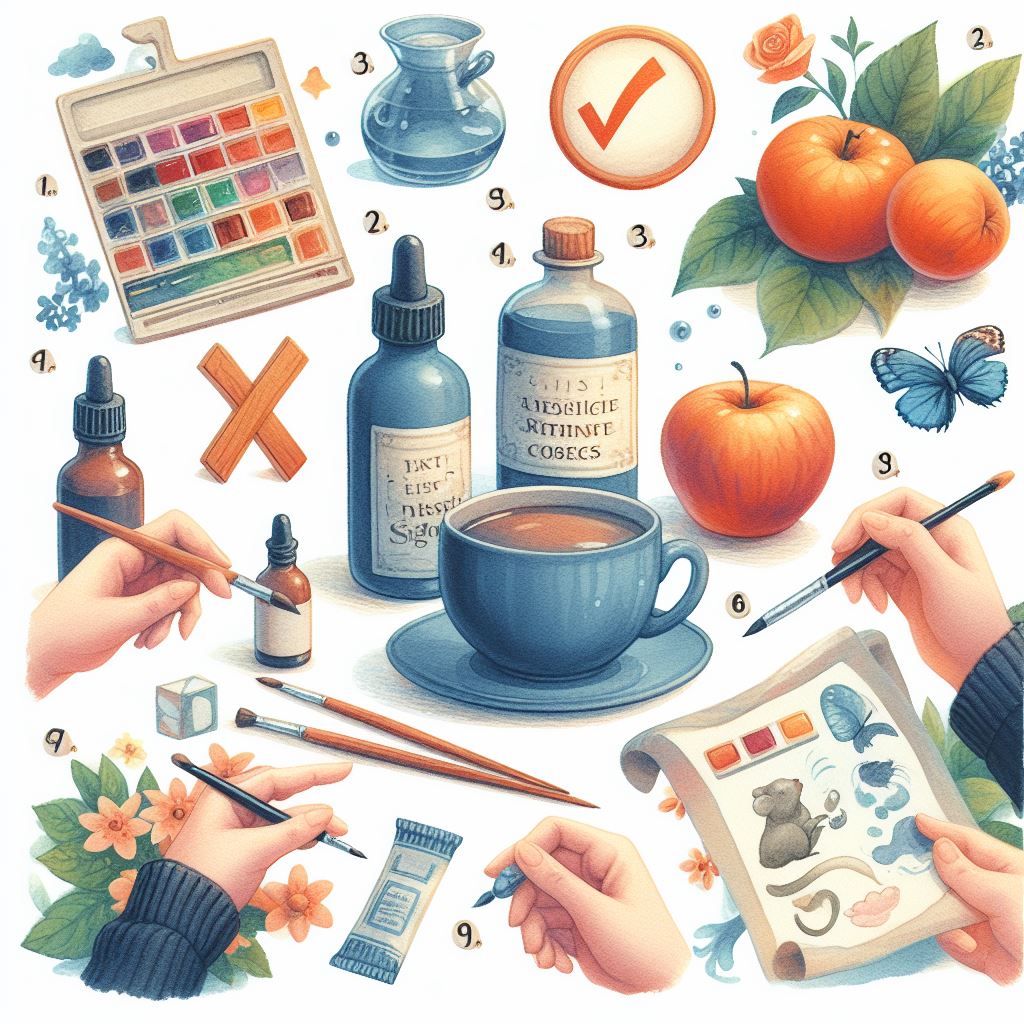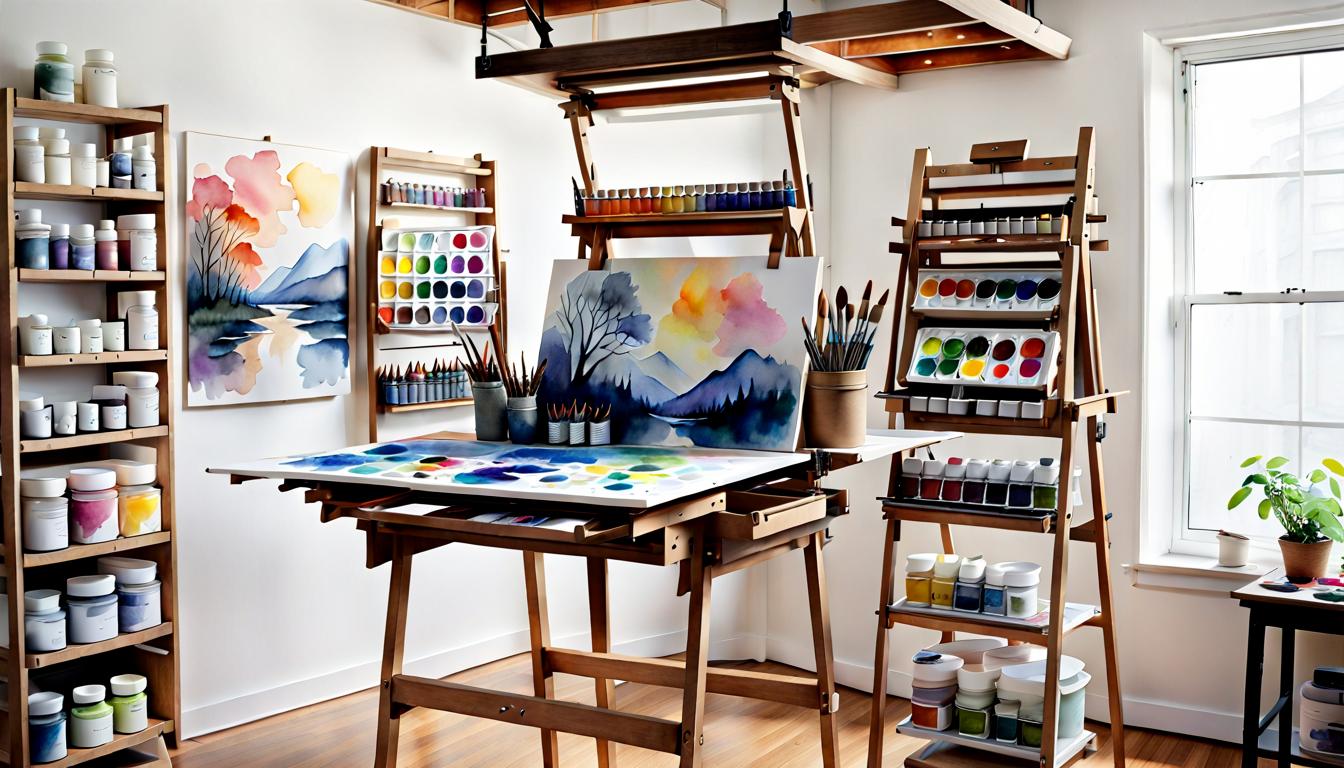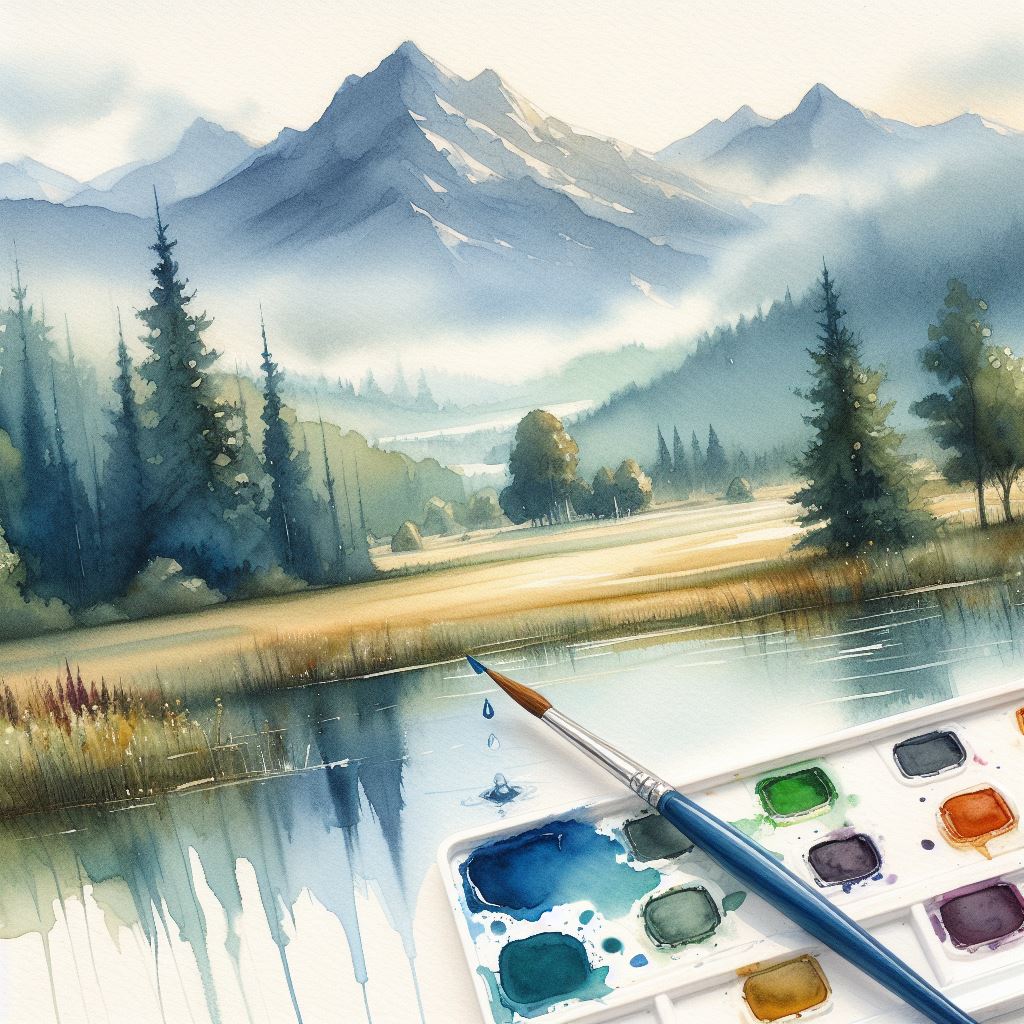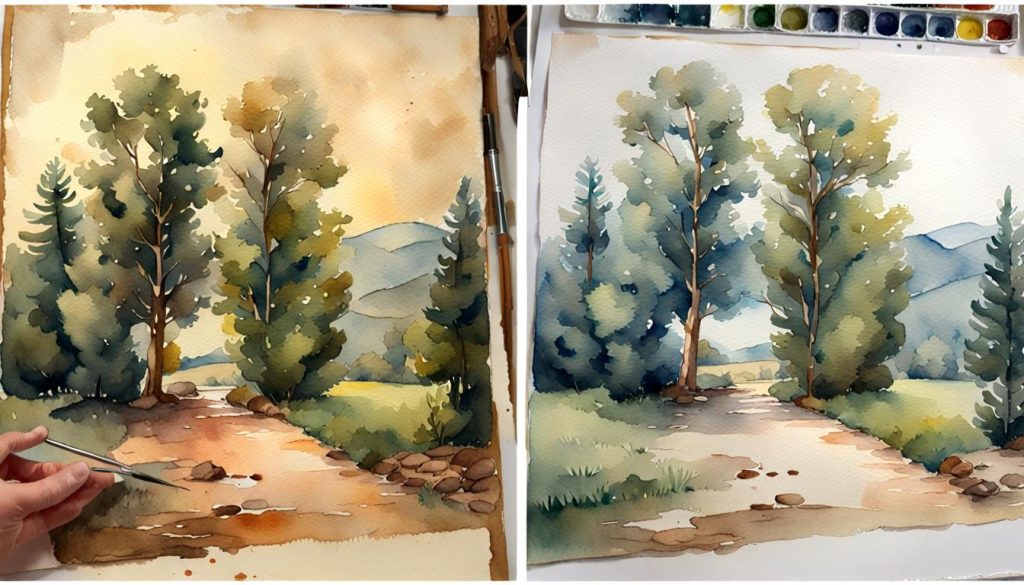
Time can paint a cruel picture on beloved watercolors, stealing their vibrancy and threatening their heritage. Fading hues, stubborn yellowing, and flaking paint become all too familiar. But worry not! Restoration of Old Watercolors is a fascinating art, offering the power to reverse damage and reclaim faded memories. In this guide, we’ll unveil cleaning secrets, explore discoloration remedies, and share essential in-painting techniques. You’ll discover the must-have supplies for minor fixes and learn when to call in the pros, ensuring your cherished watercolors continue to tell their stories for generations to come. Dive in and rediscover the magic of restored art!
The Enemies of Old Watercolors
- Light: Sunlight, especially direct sunlight, is the arch-enemy of watercolors. It bleaches pigments, causing colors to fade and lose their original intensity.
- Humidity: Excessive moisture can cause the paper to buckle and warp, while also encouraging mold and mildew growth, creating unsightly stains and jeopardizing the artwork’s integrity.
- Temperature: Fluctuations in temperature can cause the paper to expand and contract, leading to cracks and flaking of the paint.
- Pollution: Airborne pollutants, such as dust and smoke, can settle on the surface of the watercolor, dulling the colors and obscuring details.
- Improper Framing: Using acidic mats or backing materials can accelerate the deterioration of the paper and pigments.
Cleaning and Restoration of Old Watercolors
Preventive Care: A Stitch in Time Saves Nine
The best way to protect your old watercolors is through preventive care:
- Minimize light exposure: Hang your watercolors away from direct sunlight and windows. Consider UV-protective glass when framing.
- Control humidity: Maintain a consistent humidity level between 40-50% in the room where you store or display your watercolors. Use a dehumidifier if necessary.
- Maintain stable temperature: Avoid storing your watercolors in extreme temperatures, like attics or basements. Aim for a room temperature between 65-75°F.
- Protect from dust and pollution: Frame your watercolors behind glass and keep them away from dusty or smoky environments.
- Handle with care: Wash your hands before handling your watercolors and avoid touching the painted surface directly.
Simple Restoration Process
- Loose or flaking paint is a common problem in old watercolors. The key is to re-adhere stray pigment using acrylic glazing medium like Liquitex Gel Medium or Golden Acrylic Glaze.
- First, gently brush away any loose bits with a soft brush.
- Then, sparingly apply a small amount of medium to the area with a cosmetic sponge or Q-tip.
- Allow it to dry completely before gently burnishing it down with a cotton swab. This process reattaches the paint without altering the original layer.
- Another important restoration task is removing surface grime, dirt and dust which can accelerate fading over time.
- Gently wipe the painting front and back with a damp cotton swab or soft brush to lift debris.
- For minor stains, try cosmetic sponges or cotton swabs soaked in distilled water – but test on an inconspicuous area first.
Fading and Discoloration
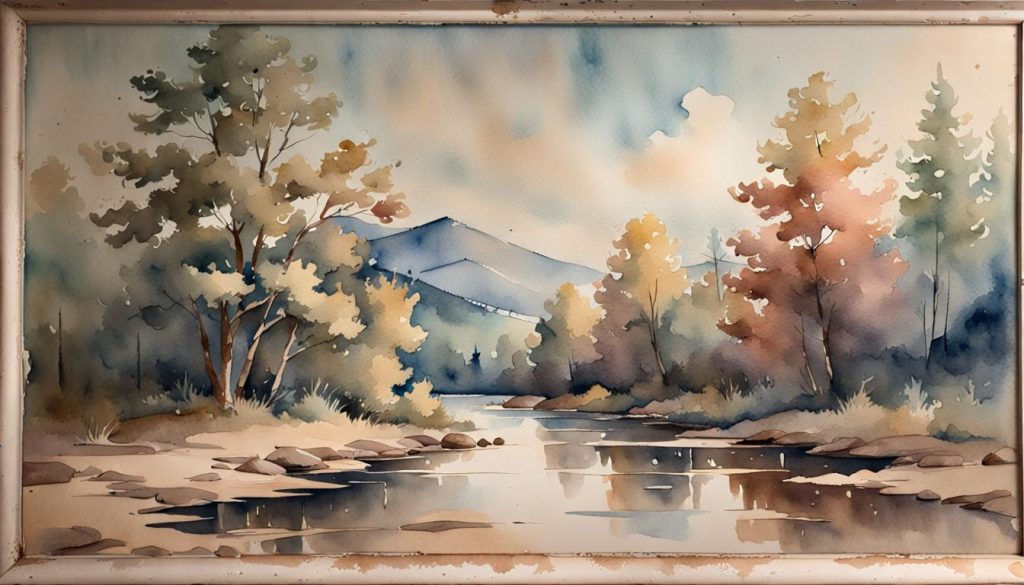
One cause of fading is dryness over the years – the pigment literally pulls away from the paper support.
- Misting the front of the watercolor evenly with a spray bottle of distilled water placed inside a humidity chamber, like a sealed plastic container, for a few hours.
- Another issue is yellowed varnish, which gives an aged appearance.
Professional guidance is the wisest for valuable pieces.
Special Techniques
No restoration is complete without addressing losses or imperfections. Missing areas can be subtly filled using watercolor pencils or soft pastels blended smoothly with a damp brush. To further disguise additions, a glaze of acrylic glazing medium toned to match may be layered and burnished over the affected spot. Similarly, any areas of stark, bright color can be softened using a diluted wash of matching watercolor paint applied with a brush and dried between layers for a natural appearance. Practice is key for seamless blending.
Essential Materials for Basic Watercolor Painting Repair at Home
| Material | Purpose |
|---|---|
| Soft cosmetic sponges and cotton swabs | Gently lift and tone paint without damaging the paper. |
| Distilled water | Resists spots and maintains pH balance for cleaning or rehydrating the paint. |
| Acrylic glazing mediums (Liquitex or Golden brands) | Perfect for reattaching loose paint or filling in shaded areas because they dry quickly and don’t reactivate dried watercolor. |
| Humidity chambers | Provide a controlled environment for gently rehydrating dried paint. |
| Quality sable watercolor brushes | Soft enough for blending and touching up details without causing further damage. |
| Watercolor pencils in a wide range of colors | Can be used to emulate faded pigments or add subtle details. |
Additional Tips:
- Always work on a clean, dry surface.
- Start with small, inconspicuous areas first.
- Test any new materials on a scrap piece of paper before applying them to the painting.
- Take your time and be patient. Restoring a watercolor painting can be a delicate process.
- Consult a professional conservator if you have any concerns about the extent of the damage or your ability to repair it yourself.
When to Seek Professional Help
- For significant damage, losses, prior restored areas or rare treasures, professional conservation is wisest to prevent further harm.
- Professionals have experience properly handling delicate materials and access to specialized tools.
- Galleries and framers can also be consulted for guidance, especially for works of high monetary or sentimental value.
Video: Professionally Restoration of Painting (Oil)
Finding the Right Restorer
Choosing a qualified conservator is crucial for the safe and effective restoration of your old watercolors. Here are some tips:
- Look for accreditation: Choose a conservator accredited by a recognized organization, such as the American Institute for Conservation (AIC).
- Experience matters: Seek a conservator with experience in restoring watercolors, especially works from your specific period or style.
- Get recommendations: Ask for recommendations from museums, galleries, or other collectors of old watercolors.
- Consult with the conservator: Discuss your concerns and desired outcome with the conservator before proceeding with any restoration work.
Protecting the Past, Brushstroke by Brushstroke
The delicate dance of aging watercolors often requires a helping hand. While basic cleaning, reattachment, and filling techniques can safeguard them from further deterioration, it’s crucial to choose supplies with care. Remember, for complex work on irreplaceable pieces, seeking the expertise of a professional conservator is key.
Just like a carefully laid tapestry, proper restoration of old watercolors preserves not just the artistic vision, but also a piece of history. From gentle cleaning to meticulous repair, skilled restoration breathes new life into these cherished works, allowing their vibrant colors and intricate details to sing once more.
But the journey doesn’t end there. Proper maintenance and storage become the guardians of these restored treasures. A controlled environment, away from harsh light and fluctuations in temperature, ensures their longevity, keeping them vibrant for generations to come.
So, as you embark on the restoration of old watercolors, remember, it’s not just about preserving pigments, it’s about preserving stories. With careful attention and the right tools, you can become a steward of these artistic legacies, ensuring their beauty and history continue to inspire for years to come.
Further Resources:
- American Institute for Conservation of Historic and Artistic Works: https://www.culturalheritage.org/
- International Council of Museums: https://icom.museum/en/
- The National Watercolor Society: https://nationalwatercolorsociety.org/
By taking proactive steps and seeking professional help when needed, you can ensure that your old watercolors continue to tell their stories and evoke treasured memories for years to come.
